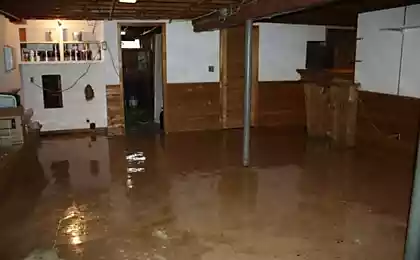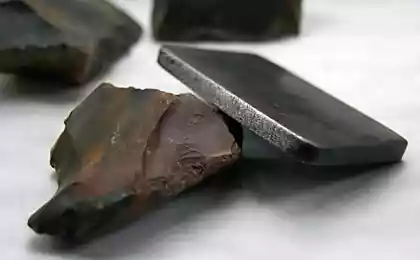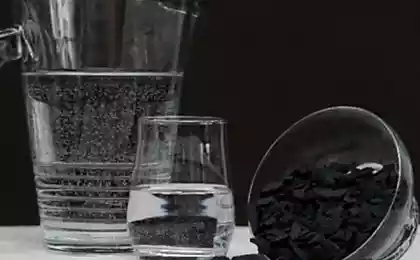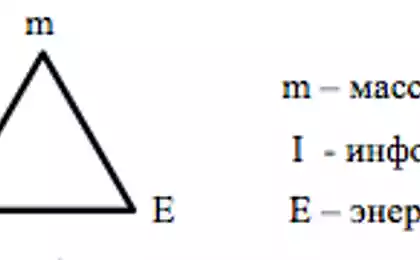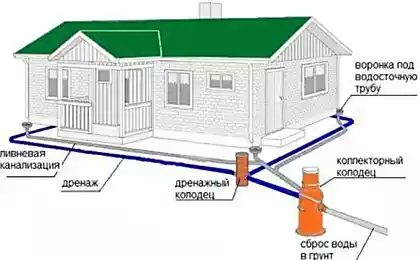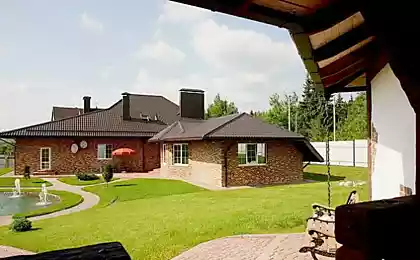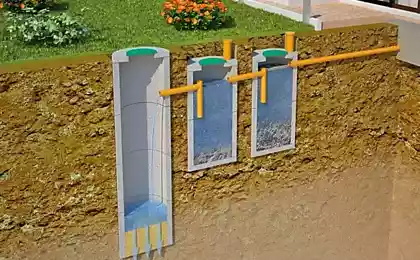567
How to deal with home flooding groundwater
If the basement is periodically subject to flooding, and to solve the problem fundamentally is not possible, you need at least to organize the pumping of water and its discharge. So we offer to get acquainted with the technique of draining cellars and used for this equipment.
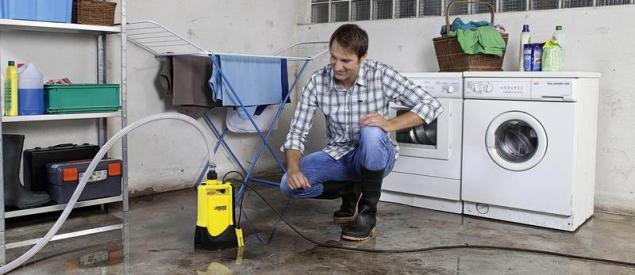
The floor work in the basement of theConstant presence of water in the basement is not only damage the supporting structure and inner equipment. First you need to solve the problem of practicality: to remove dirt and to facilitate rapid movement of water at some common point, from which it will be deleted. All work is preferably carried out in the period of maximum drop of groundwater level in summer drought or winter, if the cellar is warm.

First floor in the basement will need to be deepened. Ideally, to reduce the impact of water on the walls, to deepen the need to lower their level of occurrence in 25-30 cm the Floor needs a special way to plan, creating the correct slump. Even small changes in level can contribute to the retention of water, resulting in the basement will appear damp and the smell of stale water.
The bottom point for all slopes it is easier to place in a corner of the basement or toward the center if the floor area exceeds 20 m2. It is desirable to keep the length of the falling sloping area not more than 5-6 m. the line of descent of the slope is almost always located on the diagonal. On them place the steel pipe that is used in the manner of beacons, as when casting the screed.
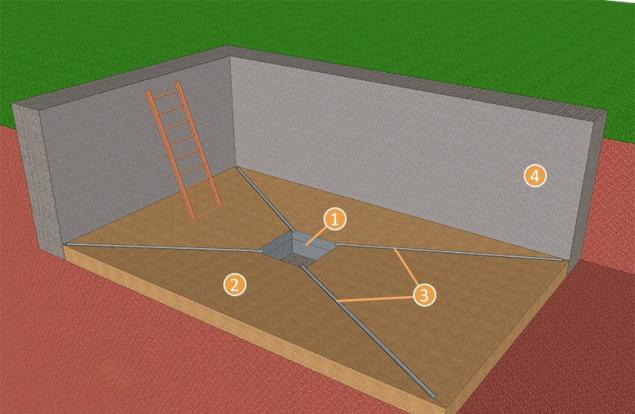
1. Pit. 2. Clay castle across the floor with a slope toward the pit. 3.Gutter. 4. The Foundation of the house
Planned gender should eventually be a pilot controlled check valve from the soaked and thoroughly compacted clay. Even if the depth has gone sandy loam, clay layer at 15-20 cm needs to be, otherwise it will be pronounced accumulation of sedimentary particles along with the water. When the device lock in 30-40 cm from the walls, the floor rises sharply at an angle of 30-35° forming a sort of podvoroty height 3-5 cm below the zero mark.
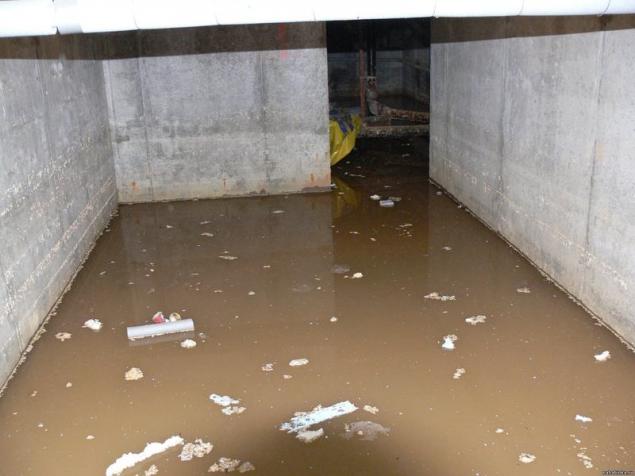
A particularly difficult case — a basement with solid concrete floors that have lost the integrity of the waterproofing. The gradients in this case are formed on the existing level through the preparatory tightening. It is very important to provide the high-quality grip with the main array, so often concrete floor has to carefully clean and use special modifiers for improving the adhesion.
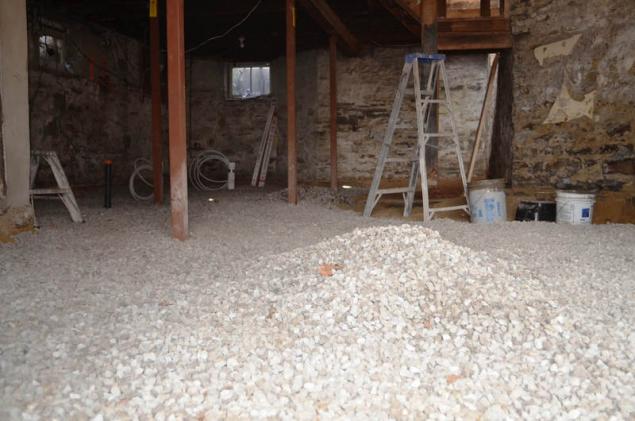
In both cases, to make the floor suitable for walking, it is necessary to lay hygroscopic filling of 20-25 cm of gravel or down through stairs. To avoid subsidence of the gravel through clay floor, it must be covered with geotextile layer. Additionally it is essential to protect walls from high humidity, use moisture resistant plaster compositions or "liquid glass".
How to build a drainage pitAt the vanishing point of the slope is arranged a pit in which to gather the flowing water. It has another purpose: in the deep cellars wide recessed "well" helps to eliminate the excess pressure of the groundwater and the consequent swelling of the floor.

The pit does not necessarily have to be arranged before the coating of the substrate, sufficiently in advance to knock down panel Board formwork for a square with sides of about 80 cm On this form and digs a small depression. The total volume of the pit should be 0.5 m3 or more if the water goes active.
The working part of the catchment, represented by the casing. Its diameter should allow the installation of float sump pump for pumping water, it's roughly 350-400 mm. Pipe can be made of both steel and asbestos cement or plastic — there is no fundamental difference. In the walls in a checkerboard pattern need to serverlet holes with a diameter of 12-14 mm with a distance of about 25 cm between them. Before installing pipe, it is recommended to wrap several layers of plastic mesh with a cell up to 5 mm.
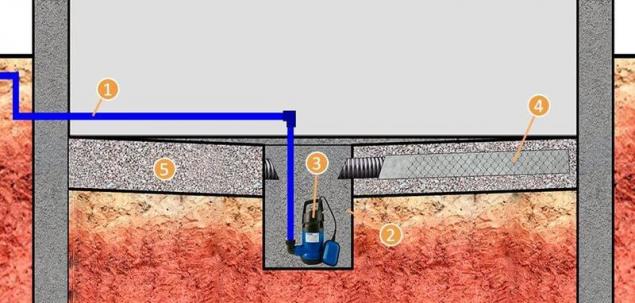
1. Pipe HDPE. 2. Pit. 3. Drain pump. 4. The drainage pipe. 5. Gravel bedding
The bottom of the casing is deaf, you need either to brew or to pour a layer of about 7-8 cm After pipe installation the formwork is removed, and the remaining space in the pit is filled with the same gravel that had been coating the floor. Install the casing it in such a way that the top edge out flush with the ground level floor. For the convenience of the passage inlet cover removable welded grid of rebar.
In the concrete floor of the pit should settle so not to disrupt the horizontal floor insulation. Easiest to fill, use 20-pound bucket from mixes that temporarily fills with water and gravel from coming up. If the sump in the basement was not provided, you must disassemble part of the floor and molding the sump, using the modified concrete with low water absorption.
Choosing a pump for pumping
For pumping water will suit most slurry pumps submersible type. The key is performance: it should be large enough to handle the volume of incoming water, at the same time overly powerful pump will operate in intermittent mode, which will affect the durability of the contact group and of the engine.
The height of the pressure column must meet the conditions of your site and prepared the field reset for the water. Usually sufficient lifting height of 10-12 m, but you should always do a little extra capacity just in case the stock pipe will not run straight or will have a greater extent.
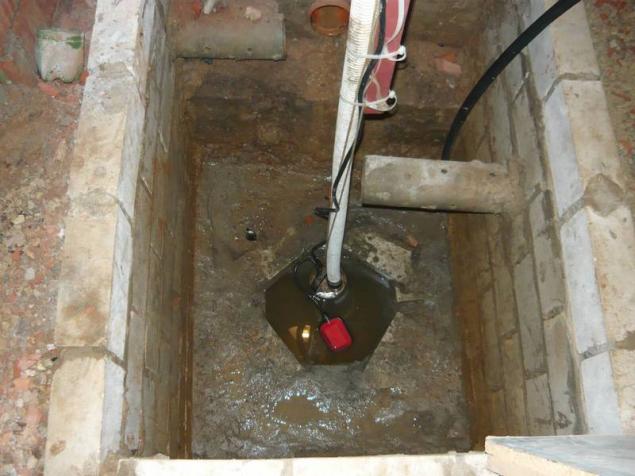
Getting all kinds of trash in the pump cannot be ruled out, although the correct device casing it will have the minimum value. The pump should be capable of pumping a sand slurry with a fraction of 3-5 mm, the specific size depends on the mesh used for filter casing.
How and what to lay a pipeFor water drainage, it is desirable to use pipe with the least hydrodynamic resistance. For pumping contaminated water optimally suitable HDPE pipe with smooth walls and the possibility of a long strip without joints. The diameter should match the outlet of the pump.
Closest to the pump station should perform the up pipe to about the level reset, that is, the first segment of pipe mounted vertically possible and without kinks. The output pipe from the basement must be done in the nearest wall, running a tunnel from the back side. Pass carefully be filled with cement mortar, recovering broken insulation.
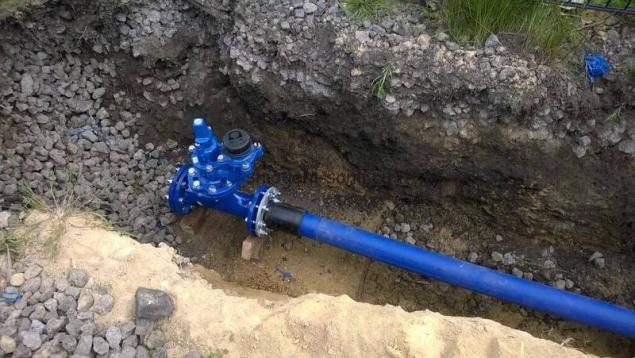
HDPE pipe can be laid without special Foundation bed, and even above the depth of frost penetration, if provided with a slope of not less than 1000:5. However, it is recommended not to lay the pipe in rocky soil and open on the surface.
Where to drop the watera Place to reset the pumped water depends on the pumping volume and intensity of flooding. For short seasonal floods are quite suitable method to discharge the water in/on the soil with the device of a simple field. The trench in which is laid perforated pipe section should be broadened and cover a major road with gravel and sand, alternating layers of non-woven geotextile. On average, one cubic meter of waste water and the length of the trench should be 6-8m.
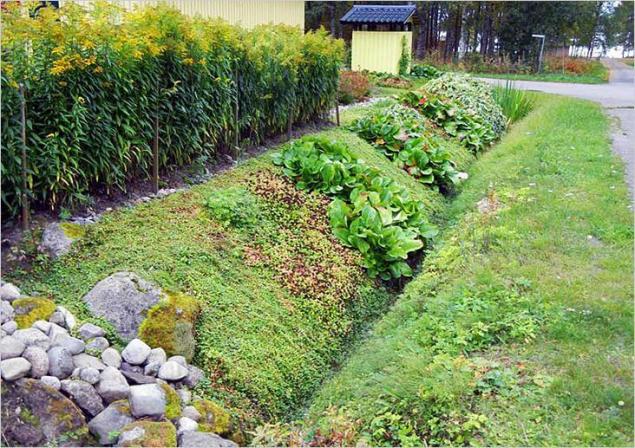
Longer requires reset of laying one's own channel to the nearest drainage or the drainage ditch. A limited amount of water can also make yourself a filter well. Don't forget, with year-round flow of water in the basement of her continuous pumping is not the best option of escape. Intense flow of moisture in the soil leads to erosion, which is reflected both on the terrain and the reliability of buildings on low-depth foundations. published
P. S. And remember, only by changing their consumption — together we change the world! ©
Source: //www.rmnt.ru/story/sewage/1203114.htm

The floor work in the basement of theConstant presence of water in the basement is not only damage the supporting structure and inner equipment. First you need to solve the problem of practicality: to remove dirt and to facilitate rapid movement of water at some common point, from which it will be deleted. All work is preferably carried out in the period of maximum drop of groundwater level in summer drought or winter, if the cellar is warm.

First floor in the basement will need to be deepened. Ideally, to reduce the impact of water on the walls, to deepen the need to lower their level of occurrence in 25-30 cm the Floor needs a special way to plan, creating the correct slump. Even small changes in level can contribute to the retention of water, resulting in the basement will appear damp and the smell of stale water.
The bottom point for all slopes it is easier to place in a corner of the basement or toward the center if the floor area exceeds 20 m2. It is desirable to keep the length of the falling sloping area not more than 5-6 m. the line of descent of the slope is almost always located on the diagonal. On them place the steel pipe that is used in the manner of beacons, as when casting the screed.

1. Pit. 2. Clay castle across the floor with a slope toward the pit. 3.Gutter. 4. The Foundation of the house
Planned gender should eventually be a pilot controlled check valve from the soaked and thoroughly compacted clay. Even if the depth has gone sandy loam, clay layer at 15-20 cm needs to be, otherwise it will be pronounced accumulation of sedimentary particles along with the water. When the device lock in 30-40 cm from the walls, the floor rises sharply at an angle of 30-35° forming a sort of podvoroty height 3-5 cm below the zero mark.

A particularly difficult case — a basement with solid concrete floors that have lost the integrity of the waterproofing. The gradients in this case are formed on the existing level through the preparatory tightening. It is very important to provide the high-quality grip with the main array, so often concrete floor has to carefully clean and use special modifiers for improving the adhesion.

In both cases, to make the floor suitable for walking, it is necessary to lay hygroscopic filling of 20-25 cm of gravel or down through stairs. To avoid subsidence of the gravel through clay floor, it must be covered with geotextile layer. Additionally it is essential to protect walls from high humidity, use moisture resistant plaster compositions or "liquid glass".
How to build a drainage pitAt the vanishing point of the slope is arranged a pit in which to gather the flowing water. It has another purpose: in the deep cellars wide recessed "well" helps to eliminate the excess pressure of the groundwater and the consequent swelling of the floor.

The pit does not necessarily have to be arranged before the coating of the substrate, sufficiently in advance to knock down panel Board formwork for a square with sides of about 80 cm On this form and digs a small depression. The total volume of the pit should be 0.5 m3 or more if the water goes active.
The working part of the catchment, represented by the casing. Its diameter should allow the installation of float sump pump for pumping water, it's roughly 350-400 mm. Pipe can be made of both steel and asbestos cement or plastic — there is no fundamental difference. In the walls in a checkerboard pattern need to serverlet holes with a diameter of 12-14 mm with a distance of about 25 cm between them. Before installing pipe, it is recommended to wrap several layers of plastic mesh with a cell up to 5 mm.

1. Pipe HDPE. 2. Pit. 3. Drain pump. 4. The drainage pipe. 5. Gravel bedding
The bottom of the casing is deaf, you need either to brew or to pour a layer of about 7-8 cm After pipe installation the formwork is removed, and the remaining space in the pit is filled with the same gravel that had been coating the floor. Install the casing it in such a way that the top edge out flush with the ground level floor. For the convenience of the passage inlet cover removable welded grid of rebar.
In the concrete floor of the pit should settle so not to disrupt the horizontal floor insulation. Easiest to fill, use 20-pound bucket from mixes that temporarily fills with water and gravel from coming up. If the sump in the basement was not provided, you must disassemble part of the floor and molding the sump, using the modified concrete with low water absorption.
Choosing a pump for pumping

For pumping water will suit most slurry pumps submersible type. The key is performance: it should be large enough to handle the volume of incoming water, at the same time overly powerful pump will operate in intermittent mode, which will affect the durability of the contact group and of the engine.
The height of the pressure column must meet the conditions of your site and prepared the field reset for the water. Usually sufficient lifting height of 10-12 m, but you should always do a little extra capacity just in case the stock pipe will not run straight or will have a greater extent.

Getting all kinds of trash in the pump cannot be ruled out, although the correct device casing it will have the minimum value. The pump should be capable of pumping a sand slurry with a fraction of 3-5 mm, the specific size depends on the mesh used for filter casing.
How and what to lay a pipeFor water drainage, it is desirable to use pipe with the least hydrodynamic resistance. For pumping contaminated water optimally suitable HDPE pipe with smooth walls and the possibility of a long strip without joints. The diameter should match the outlet of the pump.
Closest to the pump station should perform the up pipe to about the level reset, that is, the first segment of pipe mounted vertically possible and without kinks. The output pipe from the basement must be done in the nearest wall, running a tunnel from the back side. Pass carefully be filled with cement mortar, recovering broken insulation.

HDPE pipe can be laid without special Foundation bed, and even above the depth of frost penetration, if provided with a slope of not less than 1000:5. However, it is recommended not to lay the pipe in rocky soil and open on the surface.
Where to drop the watera Place to reset the pumped water depends on the pumping volume and intensity of flooding. For short seasonal floods are quite suitable method to discharge the water in/on the soil with the device of a simple field. The trench in which is laid perforated pipe section should be broadened and cover a major road with gravel and sand, alternating layers of non-woven geotextile. On average, one cubic meter of waste water and the length of the trench should be 6-8m.

Longer requires reset of laying one's own channel to the nearest drainage or the drainage ditch. A limited amount of water can also make yourself a filter well. Don't forget, with year-round flow of water in the basement of her continuous pumping is not the best option of escape. Intense flow of moisture in the soil leads to erosion, which is reflected both on the terrain and the reliability of buildings on low-depth foundations. published
P. S. And remember, only by changing their consumption — together we change the world! ©
Source: //www.rmnt.ru/story/sewage/1203114.htm
